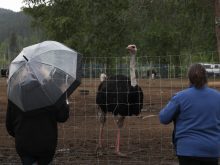Reuters/Staff — Officials in British Columbia and Washington state have confirmed new sightings of the Asian giant hornet, dubbed the “murder hornet,” indicating the invasive, predatory insect survived the winter in the Vancouver area and U.S. Pacific Northwest.
The stinging hornet, whose queens can grow as large as 2-1/2 inches in length, could potentially pose a threat to humans and the beekeeping industry, Washington state agriculture officials said Friday.
Joel Nielsen, who lives near Custer, Wash., about 16 km from the Canada-U.S. border, spotted the dead insect while walking on a roadway on Wednesday, took a photograph of it and reported the sighting to agriculture officials using an online form.
Read Also

Prairie forecast: Plenty more chances for snow over Holidays
The pattern of Pacific storm system after Pacific storm system looks set to continue for a while longer. We begin this forecast period with a heavy snowfall warning in effect across parts of Alberta.
Sven-Erik Spichiger, managing entomologist at the Washington state Department of Agriculture, said state and federal labs confirmed Friday that the Custer specimen was an Asian giant hornet.
Nielsen’s sighting, the third in that part of the state, comes just days after B.C. provincial officials confirmed Canada’s first finding of 2020, near Langley, in its furthest appearance inland so far.
According to local media, a resident stepped on a hornet May 15 and reported the dead pest to provincial officials, who identified it as an Asian giant.
“Preliminary results indicate that this is a queen, but that is going to be unofficial and pending further investigation at the lab in D.C. And what that means is more than likely a nest was able to produce breeding queens and make it through the winter,” Spichiger told reporters at a virtual news conference.
Spichiger called the finding a victory in the hoped-for eradication of the species.
“When you remove a queen, you’re basically killing the nest, especially this time of year. So we can kind of count this as a victory,” he said. “That makes us all very happy here.”
Spichiger warned, though, that the discovery could indicate more hornets in the area. If worker hornets start showing up later in the year in Department of Agriculture traps, that will indicate colonies are established, he said.
British Columbia’s agriculture ministry also wants people in the region who may have seen Asian giant hornets to report sightings to the Invasive Species Council of B.C., with photos if possible.
The so-called “murder hornet” is widely distributed in eastern Asia, from the sub-tropics of southern China to temperate zones of the Korean peninsula and northern Japan, B.C. officials said. It’s not known how it got to the West Coast but container ships have been suggested as the most likely mode of transport.
The Asian giant hornet made its first appearance in Canada last August when three were found at Nanaimo on Vancouver Island. Another Asian giant was found in November on the B.C. mainland, at White Rock.
The U.S. in December confirmed its first finding by a homeowner in Blaine, Wash., just south of White Rock.
The Asian giant, a predator of honeybees and other large insects, establishes ground nests and forages as far as eight km from its nest, B.C. officials said in September. They noted the hornets are dormant, thus unlikely to be seen, in fall and winter.
The hornets, which have noticeably large orange heads and black eyes, are able to feed on honeybees and destroy beehives in a short time period.
The B.C. ag ministry has noted several large insects common to the region — such as yellow jackets, bald faced hornets, elm sawflies and horntail wasps — could be mistaken for Asian giant hornets.
The giant hornets do not generally target people, pets or large livestock, but can attack when threatened or if their nest is disturbed.
— Reporting for Reuters by Jane Ross; writing by Diane Craft. Includes files from Glacier FarmMedia Network staff.















